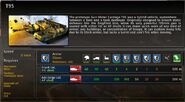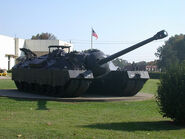The prototype T95 (originally called the T28) Gun Motor Carriage super-heavy tank was a hybrid vehicle; somewhere between a tank, and a tank destroyer. Originally designed to breach static defenses like the Siegfried line, when its powerful 105mm smoothbore gun is loaded with either AT (Anti-Tank) or HE (High-Explosive) shells. It can make quick work of any kind of armor, any buildings, or concentration of troops.
This unit can also sustain many hits, thanks to its thick armor, but lacks a turret and cannot fire while moving. It can be vulnerable to enemy air power due to lack of anti-air weaponry. When rolling, it is extremely slow, it can be routed while switching targets, as it does not have a turret.
History[]
The T95 was designed as a counter to the German heavy defenses expected of the German Siegfried Line.
It was first conceived in the spring of 1945, but proved to be too late to be used in World War II. The original name for the project was to be T95. The Pacific Car and Foundry Company designed it for the final push in Europe, but by the time the first tank was completed and ready for combat, the war was over. The original plans called for five prototype vehicles to be built, and eventually for a total of twenty-five tanks to be constructed.
As it did not have a turret, but a fixed casemate mount instead for its main armament, the T95 more closely resembled a self-propelled gun, and was redesignated as the T95 Gun Motor Carriage in 1945, but in June 1946, the vehicle was redesignated again as Super Heavy Tank T95. It has been argued that it was neither a super-heavy tank nor a self-propelled gun, but that it was in fact a very heavy tank destroyer, more accurately as an American version of one of the German Jagdpanzer-style tank destroyers, intended to take on German heavy tanks.
Two prototypes of the T95 were built. They underwent evaluation at the Aberdeen Proving Grounds and the Fort Knox facilities until 1947. In 1947 one of the T95s was heavily damaged by an engine fire during trials at Yuma Proving Grounds and scrapped, and the other T95 was reported broken up and also sold for scrap. The T95 never went into service. This was because during the later stages of T95 development and evaluation were overtaken by that of the T29 and T30 turreted heavy tank design. The T29 mounted the same gun as the T95 in a conventional rotating turret. The T30 was developed with a larger-caliber gun and more powerful engine. Due to this the T95 program was terminated in October 1947.
Overview[]
- As the T95 is very big, slow, and cannot fire while moving, it is better suited to defense than attack.
- It can fire at infantry, although it is better used as a tank destroyer.
- For the fitted name tank destroyer, it is the only tank destroyer able to fight infantry and buildings, so use this to your advantage when setting up defences.
- When sent into battle it is important to have air support - this huge target is easy prey for fighter-bombers.
- The T95 have to rotate on it's axis when looking for target, so it is highly advised to deploy units with turret alongside it. (e.g Pershing, M36, etc.)
Pros & Cons[]
-With the Pershing and Super Pershing available, you don't need this really.
- It has a potent gun and it's like a tankhunter able to deal with infantry.
- It does not have the MG which helps vehicles to slow down infantry.
- It's expensive and slow but it does not take up production space on your armour factories.
-The lack of a turret makes the AFV unable to fire on the move, it can lose to the Ha-Go if on the move and a P26 if it's getting flanked by a skilled commander and it has no support.
Weapons[]
| Weapon | ||||||||||
|---|---|---|---|---|---|---|---|---|---|---|
Giant.cal HE shell |
40 | 40 | 40 | 8 | 4 | 2 | 1 | 0 | 500 m |
| Weapon | ||||||||||
|---|---|---|---|---|---|---|---|---|---|---|
Adv.Large.cal AP shell |
500 | 200 | 100 | 50 | 25 | 20 | 500 m |
Gallery[]
Notes[]
- All American vehicles or weapons with the 'T' prefix were regarded as prototype or testing vehicles. Only after extensive testing did the vehicle or weapon advance into getting its own name. Most often, these names had an 'M' preceding it.
- The only surviving T28/95 is now a monument at Patton Museum of Cavalry and Armor in Kentucky, US. It is currently being prepared to be shipped to Fort Benning, Georgia.
- During the Second World War, the T95 hull was specially made to have an oval-ish, half egg shape-ish to bounce nearly all rounds including penetrating rounds.
See also[]
| ||||||||||||||||||||||||||



